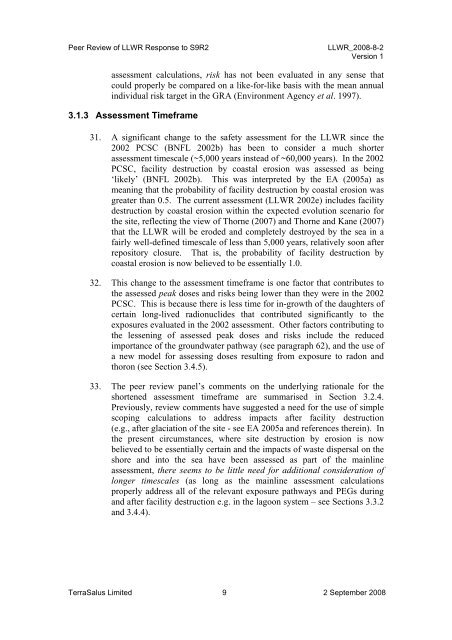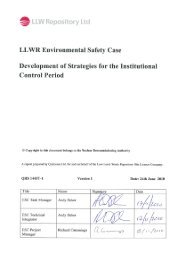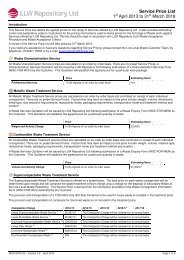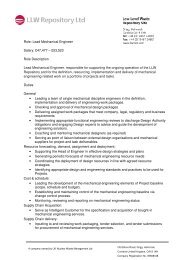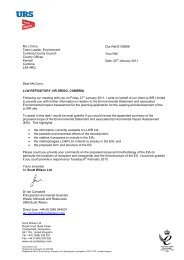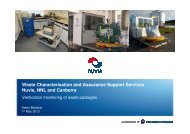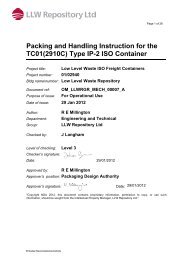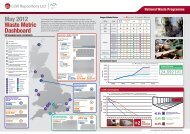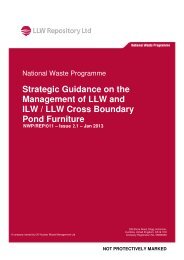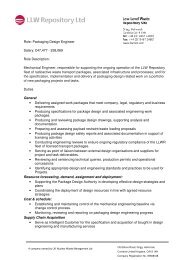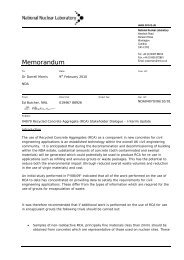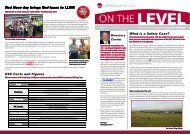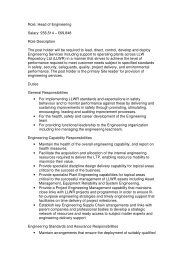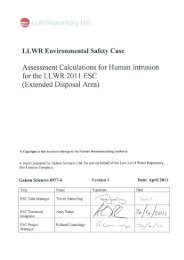Independent Peer Review of - Low Level Waste Repository Ltd
Independent Peer Review of - Low Level Waste Repository Ltd
Independent Peer Review of - Low Level Waste Repository Ltd
Create successful ePaper yourself
Turn your PDF publications into a flip-book with our unique Google optimized e-Paper software.
<strong>Peer</strong> <strong>Review</strong> <strong>of</strong> LLWR Response to S9R2LLWR_2008-8-2Version 1assessment calculations, risk has not been evaluated in any sense thatcould properly be compared on a like-for-like basis with the mean annualindividual risk target in the GRA (Environment Agency et al. 1997).3.1.3 Assessment Timeframe31. A significant change to the safety assessment for the LLWR since the2002 PCSC (BNFL 2002b) has been to consider a much shorterassessment timescale (~5,000 years instead <strong>of</strong> ~60,000 years). In the 2002PCSC, facility destruction by coastal erosion was assessed as being‘likely’ (BNFL 2002b). This was interpreted by the EA (2005a) asmeaning that the probability <strong>of</strong> facility destruction by coastal erosion wasgreater than 0.5. The current assessment (LLWR 2002e) includes facilitydestruction by coastal erosion within the expected evolution scenario forthe site, reflecting the view <strong>of</strong> Thorne (2007) and Thorne and Kane (2007)that the LLWR will be eroded and completely destroyed by the sea in afairly well-defined timescale <strong>of</strong> less than 5,000 years, relatively soon afterrepository closure. That is, the probability <strong>of</strong> facility destruction bycoastal erosion is now believed to be essentially 1.0.32. This change to the assessment timeframe is one factor that contributes tothe assessed peak doses and risks being lower than they were in the 2002PCSC. This is because there is less time for in-growth <strong>of</strong> the daughters <strong>of</strong>certain long-lived radionuclides that contributed significantly to theexposures evaluated in the 2002 assessment. Other factors contributing tothe lessening <strong>of</strong> assessed peak doses and risks include the reducedimportance <strong>of</strong> the groundwater pathway (see paragraph 62), and the use <strong>of</strong>a new model for assessing doses resulting from exposure to radon andthoron (see Section 3.4.5).33. The peer review panel’s comments on the underlying rationale for theshortened assessment timeframe are summarised in Section 3.2.4.Previously, review comments have suggested a need for the use <strong>of</strong> simplescoping calculations to address impacts after facility destruction(e.g., after glaciation <strong>of</strong> the site - see EA 2005a and references therein). Inthe present circumstances, where site destruction by erosion is nowbelieved to be essentially certain and the impacts <strong>of</strong> waste dispersal on theshore and into the sea have been assessed as part <strong>of</strong> the mainlineassessment, there seems to be little need for additional consideration <strong>of</strong>longer timescales (as long as the mainline assessment calculationsproperly address all <strong>of</strong> the relevant exposure pathways and PEGs duringand after facility destruction e.g. in the lagoon system – see Sections 3.3.2and 3.4.4).TerraSalus Limited 9 2 September 2008


